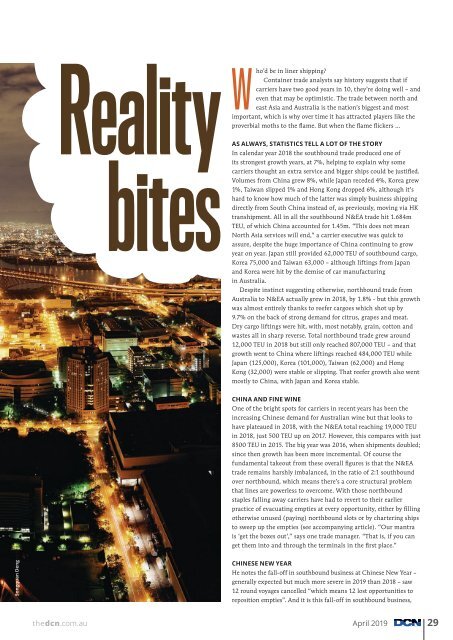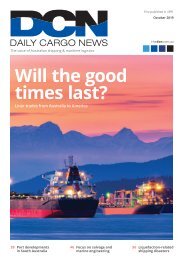DCN April 2019 Edition
You also want an ePaper? Increase the reach of your titles
YUMPU automatically turns print PDFs into web optimized ePapers that Google loves.
Reality<br />
bites<br />
Who’d be in liner shipping?<br />
Container trade analysts say history suggests that if<br />
carriers have two good years in 10, they’re doing well – and<br />
even that may be optimistic. The trade between north and<br />
east Asia and Australia is the nation’s biggest and most<br />
important, which is why over time it has attracted players like the<br />
proverbial moths to the flame. But when the flame flickers …<br />
AS ALWAYS, STATISTICS TELL A LOT OF THE STORY<br />
In calendar year 2018 the southbound trade produced one of<br />
its strongest growth years, at 7%, helping to explain why some<br />
carriers thought an extra service and bigger ships could be justified.<br />
Volumes from China grew 8%, while Japan receded 4%, Korea grew<br />
1%, Taiwan slipped 1% and Hong Kong dropped 6%, although it’s<br />
hard to know how much of the latter was simply business shipping<br />
directly from South China instead of, as previously, moving via HK<br />
transhipment. All in all the southbound N&EA trade hit 1.684m<br />
TEU, of which China accounted for 1.45m. “This does not mean<br />
North Asia services will end,” a carrier executive was quick to<br />
assure, despite the huge importance of China continuing to grow<br />
year on year. Japan still provided 62,000 TEU of southbound cargo,<br />
Korea 75,000 and Taiwan 63,000 – although liftings from Japan<br />
and Korea were hit by the demise of car manufacturing<br />
in Australia.<br />
Despite instinct suggesting otherwise, northbound trade from<br />
Australia to N&EA actually grew in 2018, by 1.8% - but this growth<br />
was almost entirely thanks to reefer cargoes which shot up by<br />
9.7% on the back of strong demand for citrus, grapes and meat.<br />
Dry cargo liftings were hit, with, most notably, grain, cotton and<br />
wastes all in sharp reverse. Total northbound trade grew around<br />
12,000 TEU in 2018 but still only reached 807,000 TEU – and that<br />
growth went to China where liftings reached 484,000 TEU while<br />
Japan (125,000), Korea (101,000), Taiwan (62,000) and Hong<br />
Kong (32,000) were stable or slipping. That reefer growth also went<br />
mostly to China, with Japan and Korea stable.<br />
Xxxxxxxxx Songquan Image Deng supplied<br />
CHINA AND FINE WINE<br />
One of the bright spots for carriers in recent years has been the<br />
increasing Chinese demand for Australian wine but that looks to<br />
have plateaued in 2018, with the N&EA total reaching 19,000 TEU<br />
in 2018, just 500 TEU up on 2017. However, this compares with just<br />
8500 TEU in 2015. The big year was 2016, when shipments doubled;<br />
since then growth has been more incremental. Of course the<br />
fundamental takeout from these overall figures is that the N&EA<br />
trade remains harshly imbalanced, in the ratio of 2:1 southbound<br />
over northbound, which means there’s a core structural problem<br />
that lines are powerless to overcome. With those northbound<br />
staples falling away carriers have had to revert to their earlier<br />
practice of evacuating empties at every opportunity, either by filling<br />
otherwise unused (paying) northbound slots or by chartering ships<br />
to sweep up the empties (see accompanying article). “Our mantra<br />
is ‘get the boxes out’,” says one trade manager. “That is, if you can<br />
get them into and through the terminals in the first place.”<br />
CHINESE NEW YEAR<br />
He notes the fall-off in southbound business at Chinese New Year –<br />
generally expected but much more severe in <strong>2019</strong> than 2018 – saw<br />
12 round voyages cancelled “which means 12 lost opportunities to<br />
reposition empties”. And it is this fall-off in southbound business,<br />
thedcn.com.au <strong>April</strong> <strong>2019</strong> 29
















